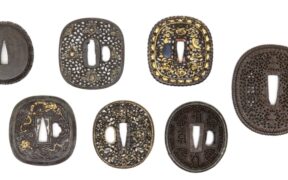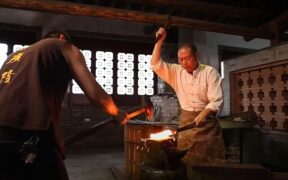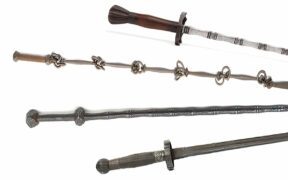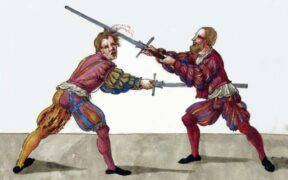Our content features commercial links to our products, committed to transparent, unbiased, and informed editorial recommendations. Learn More
Chinese Sword Fighting Styles and Their History
NO AI USED This Article has been written and edited by our team with no help of the AI
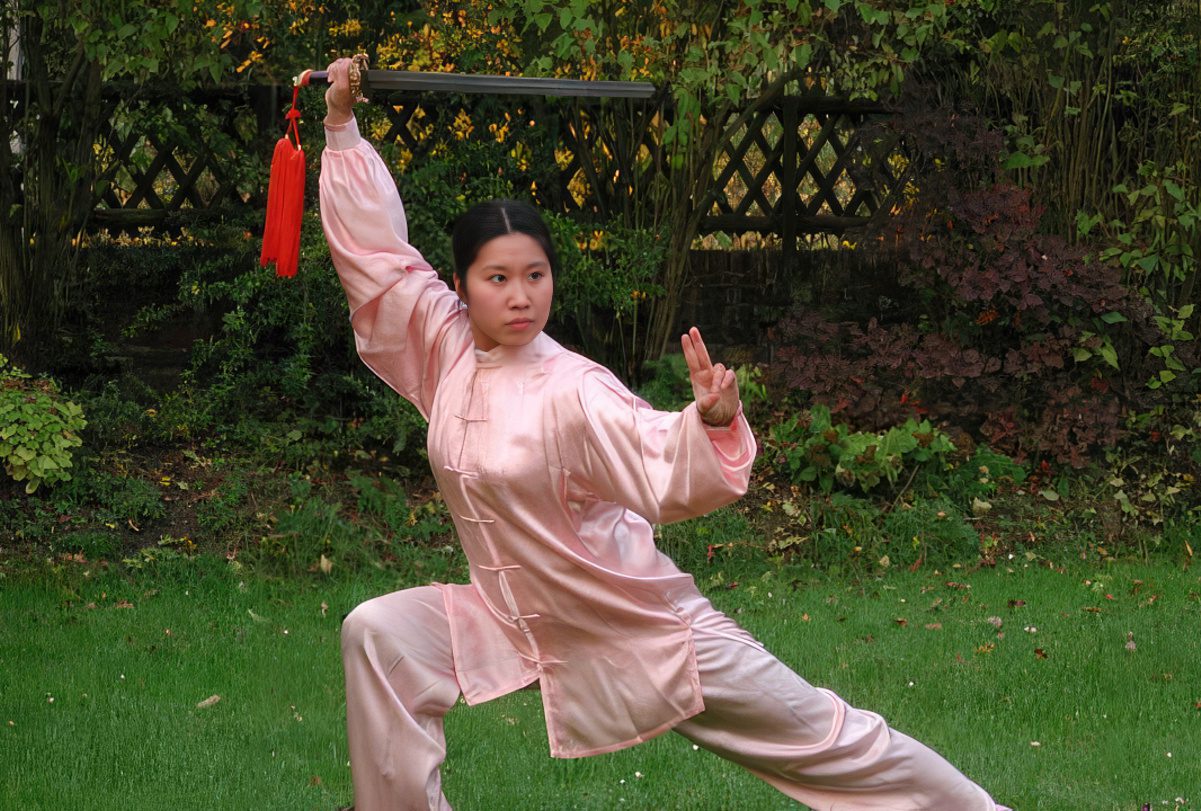
Some martial artists develop their sword fighting skills with a specific type of Chinese sword. Chinese swordsmanship centers on the straight sword jian and the curved dao. However, various martial arts systems focus on specific weapons and have different fighting applications, training methods, and styles.
Let’s explore how Chinese sword fighting varies from system to system, including the types of swords used in each.
Sword Fighting in Chinese Martial Arts
There are numerous Chinese martial arts styles and systems that involve the use of swords. Some strongly emphasize swordplay, while others incorporate Chinese swords in their forms. Still, the emphasis on swordplay may vary depending on the specific school or lineage within each style.
1. Taijiquan (Tai Chi Chuan)
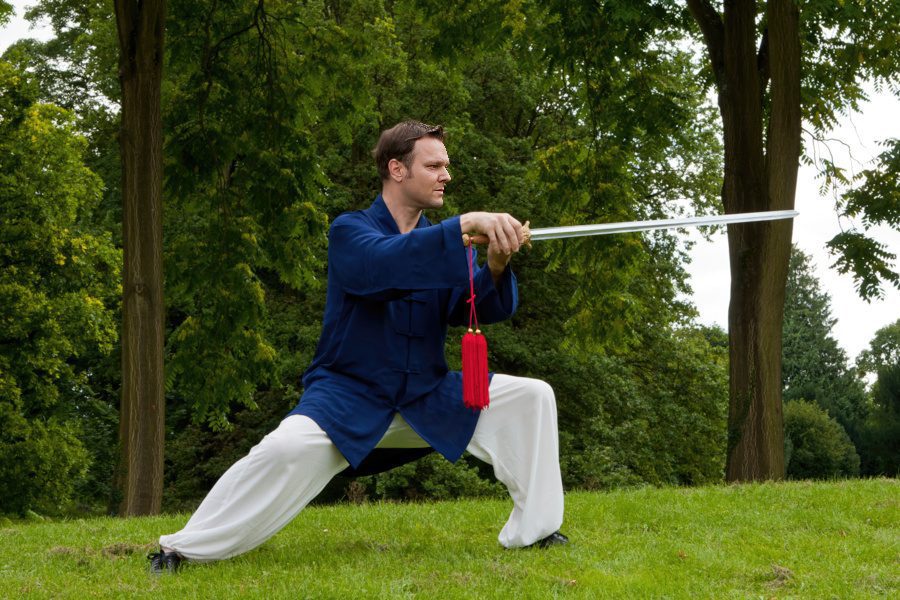
Taijiquan, also spelled tai chi chuan or tai chi, is one of the famous forms of traditional Chinese martial arts. Taijiquan means Supreme Ultimate Fist in Chinese. It is characterized by slow, graceful movements and follows the Daoist principles of naturalism.
Taijiquan incorporates swords in their form, such as the straight sword jian (also called taiji jian or tai chi sword) and the saber dao (also called taiji dao or broadsword). Practitioners also train with swords against different weapons.
However, there are several styles or schools of taijiquan, such as Chen, Yang, Wu, Sun, and so on. The Chen-style taijiquan is the basis of the most popular form of martial arts. Other styles follow Daoist principles but have differences in the forms.
2. Shaolin Kung Fu
Shaolin kung fu refers to several different types of kung fu that originated in the Shaolin temple. There are 18 Shaolin kung fu weaponry, and the four most important include the straight sword (jian), broadsword (dao), staff, and spear.
Double weapons used in training include butterfly knives, Chinese broadswords (shuang dao), hook swords (gou), and daggers. Other traditional weapons include guandao polearm, monk’s spade, tiger fork, rope dart, zi-wu or deer horn knives, nine-ring big knife, and nine-sectioned whip.
3. Wing Chun
Wing Chun, meaning Eternal Springtime, is a popular close-range style that formed the basis of Bruce Lee’s fighting arts. Generally, slapping and deflecting movements are used to disorient opponents. When fighting, practitioners intercept strikes and trap or strike an opponent. The two weapon forms taught in the art include the butterfly knives and the long staff.
4. Qingping Jian
The Qingping Jian is a stand-alone Chinese sword system that focuses on the straight sword, the jian. It reflects the ancient standards of Chinese swordsmanship, though its forms were constructed not earlier than the 1800s. The system was designed to cope with sudden changes and has a unique style, incorporating force with grace.
The Qingping Jian became famous because its movements are beautiful to watch, and its techniques are practical for actual sword fighting. However, it is the longest and has the most movements of all the well-known sword methods. There are 365 techniques, so learning one technique a day would take a practitioner one year to learn the whole thing.
5. Bagua Zhang
Bagua Zhang, also spelled Ba Gua Zhang, means Eight Trigram Palm. It is the most distinctive Chinese internal martial arts, as practitioners walk around in a circle as they practice their movements, following the shape of the bagua or eight trigrams, used in Chinese divination, philosophy, and magic.
Bagua Zhang combines circular footwork with striking, kicking, throwing, and grappling techniques. Weapons training includes the straight sword (jian), double sword (shuang jian), saber or broadsword (dao), hook swords (gou), and other traditional Chinese weapons.
6. Chuo Jiao
Chuo Jiao, meaning Poking Foot, is an indigenous martial art from northern China. It is a physically demanding martial art, focusing on kicks, sweeps, blocks, and throws. The idea behind the kick is that because the opponent is distracted by arm movements, it gives more chances of hitting its target.
The weapons used in Chuo Jiao include the straight sword (jian), two-handed long sword (shuang shou da jian), and various types of broadsword (dao), such as the chopping saber (dadao), large two-handed saber (miao dao), and double broadswords (shuang dao). The sword forms of Chuo Jiao are believed to derive from the methods of ancient China.
7. Mei Huaquan
Mei Huaquan, also spelled Meihua Quan, means Plum Flower Fist. It originated in the 17th century in northern China. Besides hand, fist, and foot forms, several traditional weapons are taught, such as the straight sword (jian) and saber (dao). Mei Huaquan also uses special weapons, often disguised as harmless agricultural tools, which were significant during the Boxer Rebellion.
8. Xing Yi Quan
Xing Yi Quan, meaning form or intention boxing, is widely practiced in northern China. Often taught with bagua zhang and taijiquan, its goal is to quickly make contact with an opponent and defeat him in a single movement. Weapon training usually includes the straight sword (jian), broadsword (dao), spear, and staff.
9. Ba Ji Quan
Ba Ji Quan means Eight Extreme Fist in Chinese. It is characterized by extremely powerful blows, where practitioners use techniques that defeat opponents with a single strike. Its weapon forms use the straight sword (jian), saber (dao), two-handed heavy blade (dadao), spear (qiang), and various types of spears. It is believed that the bodyguards of Chinese historical figures Chiang Kai Shek and Mao ZeDong were practitioners of the art.
10. Tien Shan Pai
Named after the Tien Shan Mountain in Xinjiang province, the Tien Shan Pai is a northern style of Chinese martial arts. This comprehensive style includes empty hand and weapon routines, particularly double weapons.
Chinese swords used include double straight sword (jian), double broadsword (dao), and double hook swords (gou). The Tien Shan Pai is characterized by its long stances, extended reach, kicking, and throwing techniques.
11. Emei Quan
Named after the Emei Mountains in Sichuan province, the Emei Quan is famous for its animal styles, incorporating techniques from monkey-style kung fu. Its characteristic feature is that practitioners use force to deliver strikes and divert attacks from opponents.
Training involves using weapons, such as a straight sword (jian), broadsword (dao), thirteen whips, and hidden weapons, especially the hairpin and the needle. Its forms involve low, strong stances, hopping movements, and powerful flipping actions.
12. Bak Fu Pai
Bak Fu Pai literally means White Tiger Kung Fu in Chinese. It involves several southern-style Chinese punches, kicks, and iron-palm strikes. While it primarily focuses on empty-hand combat, it does include some weapons training on the straight sword (jian) and double hook swords (gou).
13. Bak Mei
Bak Mei literally means White Eyebrow in Chinese and is named after its founder. It is a close-range fighting art that involves jabbing, thrusting, aggressive punches, and blocks in partner drills. Weapons in training include the sword (jian), saber (dao), staff, and others. The style has been fictionalized in the Hollywood film Kill Bill: Volume 2.
14. Liu He
Liu He translates as Six Harmonies in Chinese. The principle of this art is that the impact of a strike is much stronger when the body moves in harmony. It emphasizes the coordination of hips and shoulders, knees and elbows, and feet and hands. The sword form incorporates the use of the straight sword jian.
15. Duan Quan
Duan Quan means Short Distance Fighting and is popular in Hebei province, China. It focuses on close-range techniques, where practitioners utilize unusually low stances to disorient opponents. Unlike other types of martial arts, jumping movements are discouraged.
Apart from empty-hand combat, there are several weapons used. Its weapon routines utilize the straight sword (jian), single broadsword (dan dao), double broadsword (shuang dao), double hook swords (gou), and double daggers (shuang bi shou).
16. Yau Kung Moon
Relatively unknown in the West, Yau Kung Moon translates as the style of flexible power, and it originated in the Henan province in China. It has a Buddhist origin and is considered an internal art, but the system also includes weapons training, such as double broadswords (shuang dao) and single and double daggers.
Modern Yau Kung Moon is heavily influenced by the yin and yang philosophy. Generally, the opponents’ forces are often redirected against them, and the striking actions are delivered with the ging power developed by rigorous breathing exercises. Fighting techniques include hand strikes, kicks, headbutts, and wrestling techniques.
17. Northern Praying Mantis
Northern Praying Mantis combines the footwork techniques from monkey-style kung fu with hand techniques from praying mantis. It is characterized by a unique poking-hand posture, which uses a hooking claw-like action to divert incoming threats. Like many Chinese martial arts, it also incorporates the practice of swords, including the straight sword (jian) and broadsword (dao).
18. Black Crane Kung Fu
Black crane kung fu focuses on strength training, deflection techniques, and qi gong breathing meditation. The elements of bagua zhang and xing yi quan can also be seen in the system’s footwork routines. The most popular weapons used in training include the straight sword (jian), baton, spear, staff, and cane.
19. Northern Eagle Claw
Tao Lun in Chinese, the Northern Eagle Claw was created by General Yue Fei in the 12th century. Many of its movements are similar to the movements of an eagle in flight and pursuit of its prey. It is primarily an offensive form of fighting rather than a defensive martial art. It focuses on clawing, striking, punching, and throwing techniques.
The Northern Eagle Claw uses various weapons in training, including the straight sword (jian) and saber (dao). It also utilizes double weapons like double straight swords, double sabers, double hooks, and double daggers. It is also famous for its spear techniques and use of flexible weapons, including the three-sectional staff and the chain whip.
20. Tong Bei Quan
Tong Bei Quan means Power from the Back Fist, and many of its techniques come from the back, shoulders, arms, and fists or hands. It is believed to have originated during the Qing dynasty when it was called qi boxing. Weapons used in training include the straight sword (jian), saber (dao), and whip.
21. Ba Faquan
Ba Faquan, meaning Eight Method Style, is a combination of several Chinese martial arts systems and was used by militia during the overthrow of the Qing government. It was a simplified hand-to-hand combat training, and many techniques were designed for use on foot or horseback. Training with the broadsword or saber (dao) is featured heavily in the system.
22. Mizongyi
Mizongyi, meaning Lost Track Fist, is of Shaolin origin. It is known by several names, such as Mizongquan, Yanqingquan, and Yanqingjia. Its most unique movement is the fajing—or the discharging of body force—that is brought by simultaneous twisting of the knees, hips, waist, elbows, and hands.
Weapons training involves various types of broadswords (dao), straight swords (jian), hook swords (gou), daggers, spears, staffs, and hard whips. During sparring, masters usually employ fajing into their opponents, knocking them backward.
23. Fujian White Crane
A martial art inspired by the fighting style of the crane, the Fujian White Crane involves striking vulnerable areas of the body. Initially, empty-hand skills are emphasized, but training with classical weapons is eventually introduced to practitioners. Weapons taught include straight swords (jian), double swords, sabers (dao), double sabers, short swords, horse-cutter swords, daggers, tiger forks, and so on.
24. Five Ancestors Fist
Five Ancestors Fist combines the elements of Shaolin systems. It borrows the striking methods of chang quan, the hand techniques of fujian, the footwork from hou quan, the power-generation techniques of luohan quan, and the breathing methods of iron qi gong.
Five Ancestors Fist includes training in traditional Chinese weapons, such as the straight sword (jian), broadsword (dao), trident, staff, and spear. It also uses several improvised weapons, including rice bowls, chopsticks, and opium pipes.
25. Fut Gar
Fut Gar, meaning Buddha’s Palm, is a southern kung fu style characterized by palm strikes, low kicks, and evasive footwork. Originally a generic term for the kung-fu style used by monks, Fut Gar is now considered a distinct style in its own right. Weapons used in training include the straight sword (jian), broadsword (dao), butterfly swords, guandao polearm, the monk’s spade, tiger fork, and so on.
26. Hung Gar
Named after its founder, Hung Gar is characterized by strong hand techniques and tiger’s claw movement. The system’s techniques focus on simultaneous striking and blocking, with blocks often used to attack opponents. Weapons include butterfly swords, sabers (dao), guandao polearms, tiger forks, spears, and so on.
27. Hung Fut
Hung Fut is a hybrid southern Shaolin-based kung fu and is a left-handed style. It combines several training methods and techniques from other systems, such as hung gar, crane, fut gar, dragon, snake, tiger, and leopard.
Generally, Hung Fut practitioners undergo iron-rings training, in which heavy iron rings are placed over the arms while performing punching drills. They are taught the use of 20 weapons, including the straight sword (jian), broadsword (dao), butterfly knives, hook swords (gou), daggers, axes, staffs, spears, and so on.
28. Lai Tung Pai
Lai Tung Pai, translated as Family of Lai Tung Village, is a martial art of Shaolin origin. It was known initially as poon kuen or encircling fist. It is often compared to Wing Chun due to its close-combat techniques. Weapons taught include the broadsword (dao), butterfly knives, and the sparring equipment called mook jong (eight different wooden men).
29. Choy Li Fut
Named after its founder and in honor of Buddhist roots, Choy Li Fut includes both northern and southern styles. Its techniques are derived from five Shaolin animals: tiger, leopard, crane, snake, and dragon. Choy Li Fut uses several traditional weapons, including various types of broadswords and sabers (dao), butterfly knives, straight swords, double swords, double daggers, hook swords, and so on.
30. Hung Sing
A variant of Choy Li Fut, Hung Sing (meaning Glorious Victory), was developed by Hung-Sing Jeung, utilizing his experiences as a security guard. Practitioners use the straight sword (jian), broadsword (dao), butterfly knives, and sword-and-shield. Initially, Hung Sing was only taught to Chinese people, but now has several practitioners in the U.S., especially in San Francisco.
31. Lau Gar
Also known as Lau Family Fist, Lau Gar is based on the movements of the five Shaolin animals. Its fighting strategy is derived from Buddhist philosophy and qi gong. Today, it is one of the most popular styles of kung fu practiced in the U.K. Weapons training includes the use of the broadsword (dao), butterfly knives, straight sword (jian), and other traditional Chinese weapons.
32. Dragon Fist
The Dragon Fist may not be based on the dragon’s movements but on its spiritual qualities. Its primary focus is on the palm, fist, and claw techniques to overcome opponents of greater physical capacity. It uses several traditional Chinese weapons, including the straight sword (jian), spear, and a long staff.
33. Sansoo
Sansoo, meaning Unbound Hand, was originally developed by monks in the Kwan Yin temple in Guangdong province for self-defense. It was designed to disable an opponent within three strikes and to end the fight quickly. It mainly uses the principles of power, speed, and leverage. However, the system has no set patterns, making it a highly adaptable style. Some practitioners utilize the Chinese saber (dao) in training.
34. Feng Shou
Feng Shou, meaning Hand of the Wind, is an internal taijiquan self-defense system characterized by fast, continuous attacks and blocks and circular movements of the hands. It utilizes the posture and blending hand from li-style taiji. Practitioners typically use the Chinese broadsword or saber (dao) and staff in training.
35. Zui Quan
Zui Quan, meaning Drunken Fist, is an exotic kung fu and wushu system. It is designed to hide combative strikes with drunken-like, unsteady movements to confuse an opponent. The idea behind the drunken style is that fighting opponents while pretending to be drunk may cause them to drop their guard, giving a practitioner an advantage.
Weapons typically feature the straight sword (jian) and the broadsword (dao). It has been the subject of several martial arts films in Hong Kong and was featured in Jackie Chan’s film Drunken Master.
Facts About Chinese Sword Fighting
Sword fighting skills can be developed with different types of swords. Some Chinese swords were designed by the military for war while others were developed by martial artists to make special skills possible.
- Chinese martial arts and swordsmanship trace their origins to various sources.
Some were derived from ancient military skills and Chinese swordsmanship, while others were Daoist martial arts from the Wudang temple in Hubei province. There were also Buddhist martial arts that evolved from the Shaolin temple. Others were techniques used by secret societies, militias, bandits, and invaders throughout China’s history.
- Chinese martial arts can sometimes be categorized into different families.
Some martial arts are internal (soft), while others are external (hard). Others are categorized by geographic location, such as northern or southern style. Northern styles generally have fast movements and powerful kicks, while Southern styles usually have strong hand techniques and stable stances. Also, some Chinese martial arts mimic the movements of animals.
- The sword fighting skills using the dao are among the most efficient in combat.
The dao was among the most commonly used weapons in the Chinese army. The basic dao skills are easy to teach, learn, and use, making them the most useful in battlefield combat. Generally, the infantry used the short dao, while the cavalry utilized both the short dao and long-handled dao. Also, the taiji dao skills were designed to defend against spears.
- Many of the ancient swordsmanship skills on jian have been lost.
Since the Jin dynasty, from 265 to 420 CE, the straight sword jian had not been used as a battlefield weapon. Its use as a self-defense weapon was only revived during the late Ming and early Qing dynasties.
As a result, many ancient jian skills have been lost, and the modern practice of jian is limited to single routines which are part of a martial school curriculum. Also, various straight sword forms that emerged from overall martial systems are more prevalent than stand-alone sword systems.
- Sword fighting utilizes various parts of the sword and different skills.
In taijiquan, the basic skills of taiji dao include using the saber blade, the guard, the handle, and the pommel ring in sword fighting. Other skills involve transferring the weapon from one hand to the other and more. The empty-hand skills are also practical, usually for grabbing the opponent’s weapons.
- The regular dao should not be confused with the taiji dao.
The taiji dao is a specialized sword used exclusively in the taijiquan to improve sword skill practice. Still, it is not uncommon today that many practitioners use a regular dao to practice the taiji dao form. Some of them were oxtail saber (niuweidao), goose-feather saber (yanlingdao), and willow-leaf saber (liuyedao). Most of these have shorter blades and handles than the taiji dao, and using them may hinder some techniques.
- The taiji dao differs from the regular dao in form practice.
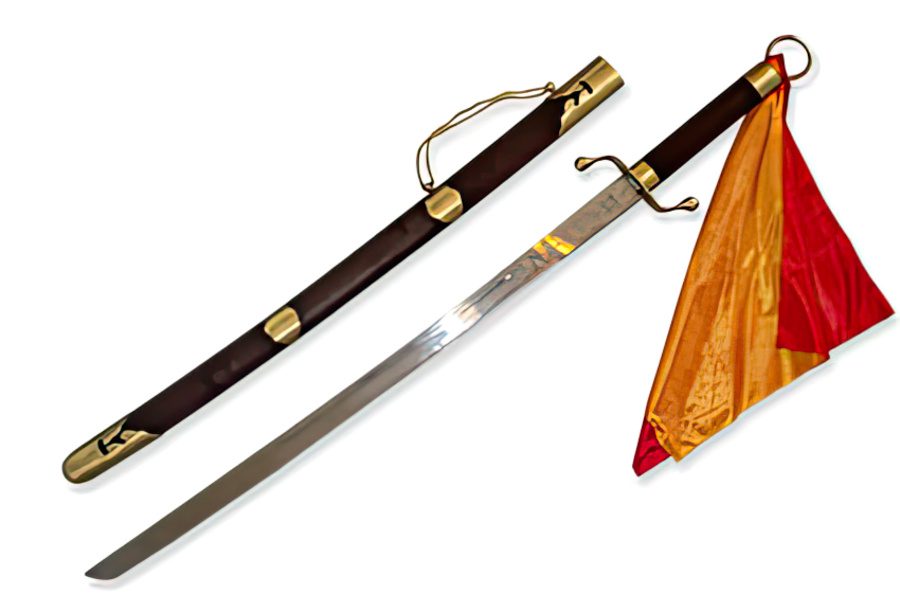
The unique shape of the taiji dao allows the execution of some techniques. Unlike the regular dao, also called saber or broadsword, the taiji dao has a slender shape and should not be used with great force. The latter also has an S-shaped hand guard that allows one to develop some skills not possible with a regular dao, such as hooking the opponent’s weapon. The ring pommel of a taiji dao also allows easier control of the weapon.
- The taiji dao allows one or two-handed use.
The handle of a taiji dao is longer than that of a regular dao, so some sword skills require two-handed grips. In fact, the taiji dao form includes some hidden two-handed gripping skills. Still, the thirteen-posture form, the main focus of dao training, is mainly executed with only one hand holding the weapon.
- Taijiquan practitioners train in single- or double-sword skills.
In traditional taijiquan, only one dao is used, often referred to as the dan dao (single-dao skills). Still, some practitioners developed shuang dao (double-dao skills), in which each hand holds one sword, and the weapons are used in a coordinated way. Some groups also combine the single dao practice with the practice of other weapons, such as a whip, a shield, or hidden weapons.
- Some martial arts masters incorporated Japanese sword skills into Chinese sword practice.
During the Ming dynasty, martial arts master Cheng Chongdou studied the traditional Chinese dao and then learned Japanese sword skills. In his book A Selection of Single-Sword Skills, he incorporated many Japanese sword skills into the traditional Chinese sword practice. Most of these dao postures are still used today in many martial arts groups.
- Wushu is a modern Chinese sport focusing on skill and fighting techniques.
The term wushu (武术) means martial technique. It is sometimes called kung fu, and both terms generally refer to Chinese martial arts. While it has a long history, the International Wushu Federation was established in 1990 to regulate many types of Chinese martial arts under the wushu category.
Today, the main disciplines of wushu include choreographed routines (taolu) and full-contact combat (sanda). The former includes bare-handed taijiquan, taiji jian—a tai chi with a straight sword jian—and daoshu, which utilizes a broadsword. On the other hand, sanda is the fighting form of wushu.
History of Chinese Sword Fighting
Chinese swords had many variations throughout history and martial artists utilized the weapons that were available during their time. The straight sword jian was initially more common than the curved dao, as it was easier to manufacture, though the latter eventually became the widely used battlefield weapon.
In Han Dynasty
During the Han dynasty, from 206 BCE to 220 CE, swordsmanship became highly respected and popular. Sword fighting in the form of duels was common among martial artists to settle disputes. Swordsmen also made their living based on their fencing skills.
Some swordsmen served as warriors camped on the border where Han troops dealt with invasions. Sword fighting techniques also formed routine sets which were often performed as dances by ones who were not experts in martial arts.
In Ming Dynasty
By the Ming dynasty, from 1368 to 1644, sword fighting became a practical battlefield skill and self-defense. The single-edged, curved dao served as the close combat weapon of the Chinese military. The basic dao skills were easy to learn and use under extreme conditions, so they were most useful for battlefield combat.
Still, Ming general Qi Jiguang believed that the success of his army on the battlefield depended on its ability to function as a group instead of the skill level of one soldier in an army. So, he organized his army into fighting groups, where each soldier mastered only a few skills that complemented those of other soldiers within the group.
In Qing Dynasty
During the Qing dynasty, from 1644 to 1912, sword fighting skills using the dao became more refined and the military incorporated them into their training systems. The Qing military also used different types of dao of various sizes. However, the widespread use of firearms eventually diminished the importance of swords and martial arts training in the army.
Conclusion
Many martial arts practitioners hone their sword fighting skills using different types of Chinese swords. However, Chinese swordsmanship today is largely based on the martial artists’ specialization in a single sword routine rather than an overall martial arts system. There are also many martial arts schools that revive the historically accurate Chinese sword fighting skills, from solo forms to partnered drills and free swordplay.
